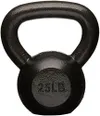
No, you don’t need to do endless sit-ups or crunches to strengthen your core or build ab muscle — I’ve got an exercise for you that's low impact, can be done anywhere using your bodyweight or a set of the best kettlebells, and slots easily into any core workout, functional routine, warm-up or strength session.
Sure, there’s a place for sit-ups and crunches in workouts. But my favorite way to train the various core muscles is by doing two things: using functional movement (movement patterns that closely mimic daily activities, like pushing, pulling and climbing) and compound exercises — ones that hit multiple muscle groups at once and rely on your core for stability and power.
If you're feeling keen to kick overused abs exercises to the side, here’s another one to try. I also cover the benefits, muscle groups you’ll target and how to do it yourself with scaling options for all levels.
What is the low-impact exercise for strengthening your core?
Inchworm walkouts and walk-ins aren’t the first moves you’d think of to engage your core muscles but engage them they do. Better still, you can add kettlebells to the exercise to make the move more accessible and challenging at the same time.
When I say “strengthen the core,” it’s crucial to understand what that means. Your core muscles are collective — not just those rippling six-pack muscles that create a cut-looking torso. That’s good news because there’s more to your core than how it looks.
Strengthening the various core muscles builds stability, helps you move, balance and function optimally, withstand impact and supports good posture. If you’re unfamiliar with these muscles, I recommend getting to know them better and reading our abs versus core muscles explainer.
Lululemon The Mat 5mm @ Lululemon
Lulu gives you a plush 5mm thickness and a grippy top layer with a rubber base, making this mat versatile and reversible. This particular mat won our Tom's Guide Awards for best yoga mat.
How to do inchworm walkouts and walk-ins with or without a kettlebell
- Start in a plank position with your shoulders stacked over your wrists, hips aligned with your shoulders and stomach, glutes and quads engaged
- Keeping your shoulders over your hands, walk your feet toward your hands
- Try to keep your legs as straight as possible until you reach a forward fold position
- Without standing up, begin walking your hands away from you until you reach a high plank position again
- Continue for reps.
You must keep your stomach, glutes and shoulders braced and maintain a bend in the knees if you suffer from tight hamstrings. If you can, keep your legs as straight as possible to help engage the muscles along your posterior chain — the back of the body — and make the drill more challenging.
Sign up to get the BEST of Tom's Guide direct to your inbox.
Get instant access to breaking news, the hottest reviews, great deals and helpful tips.
To progress the exercise:
- Start in a plank position, gripping a kettlebell by the handle in each hand
- Perform the steps above, walking your feet just behind the bells. The elevated bell position will make this stage of the exercise easier
- Lower your hips, lift your chest and keep your stomach braced, then perform a kettlebell deadlift, standing tall with the bells
- Draw your shoulders back and down
- With control, bend the knees, lower the bells to the floor again, then walk your feet back until you return to the high plank position.
Deadlifts famously recruit the core muscles to help drive the powerful concentric phase of the movement (standing with the weights) and stabilize the body as you lower them again. You’ll still use your core muscles as you stabilize and balance the body walking your feet in and hands out.
Verdict
Even though there are well-known low-impact abs exercises for your back, it’s still a pretty subjective area. For example, leg raises technically support the lower back on the ground, still, many people struggle with them, especially if they cannot generate enough core activation to lift and lower the legs without arching the back, which puts added strain on the lumbar spine.
Planks are also seen as low impact, but again, a lack of glute, quad and core engagement can send the hips downward, placing pressure on the lower back. It all starts with learning step-by-step how to engage your core muscles properly.
If you have lower back pain, injuries, or sciatica, are pre or post-natal, or have an illness, I strongly recommend clearing exercise with a qualified medical professional first. The forward fold position and walkouts can be uncomfortable for some people, so stop if you experience discomfort or pain at any time.
The most effective ab-strengthening exercises are the ones you can do with proper form and scale as you get stronger without experiencing unnecessary pain. As you move, focus on driving through your powerhouse — gently squeezing the muscles in your glutes and stomach as you breathe throughout.
More from Tom's Guide
- Ditch the gym — you just need 1 kettlebell and this 5-move low-impact workout to build muscle all over
- The Reebok Nano Gym shoe made me switch my Hyrox training shoe - here's why
- I'm a personal trainer — 3 things I wish I had known about stretching and mobility when I started exercising

Sam Hopes is a level 3 qualified trainer, level 2 reiki practitioner and senior fitness writer at Tom's Guide. She is also currently undertaking her Yoga For Athletes training course. Sam has written for various fitness brands and websites over the years and has experience across brands at Future such as Live Science, Fit&Well, Coach, and T3.
Having worked with fitness studios like F45 and Virgin Active, Sam now primarily teaches outdoor bootcamps, bodyweight, calisthenics and kettlebells. She also coaches mobility and stretching-focused classes several times a week and believes that true strength comes from a holistic approach to training your body.
Sam has completed two mixed doubles Hyrox competitions in London and the Netherlands and finished her first doubles attempt in 1:11.









